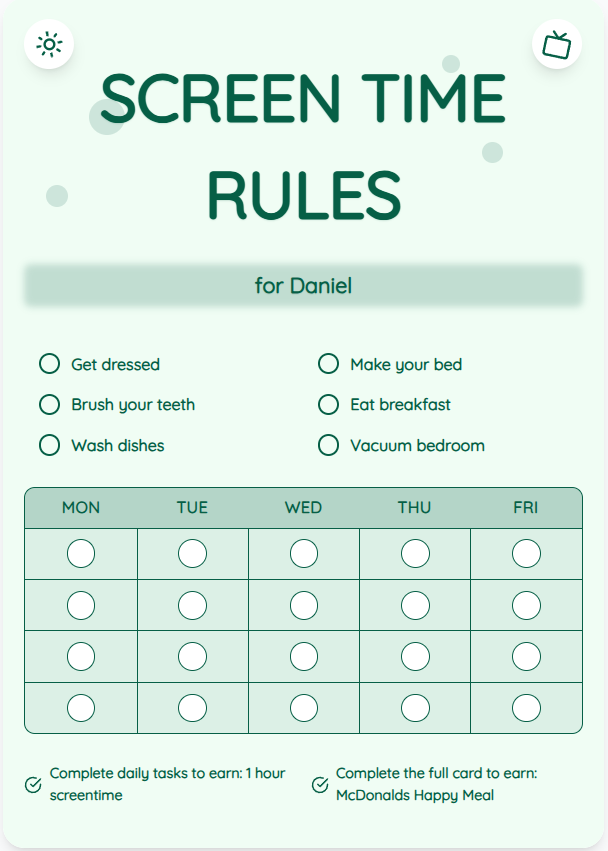Setting Healthy Screen Time Limits for Children: A Parent's Guide
As a parent, managing your child's screen time can be challenging. Find the right balance between digital engagement and other activities is crucial for their development. In this guide, we'll provide expert advice and actionable tips to help you navigate the world of screen time limits for children aged 2-12.
See What Your Screen Time Chart Will Look Like
Here's an example of a beautiful, customizable screen time rules chart you can create for your family

Understanding the Guidelines
The American Academy of Pediatrics recommends that children aged 2-5 should have no more than one hour of screen time per day, while children aged 6 and older should have consistent limits on their screen time. It's essential to consider your child's individual needs and interests when determining the appropriate screen time limits.
Creating a Screen Time Schedule
Establish a screen time schedule that works for your family. Include designated screen-free times such as during meals and before bedtime. Encourage alternative activities like outdoor play, reading, and creative hobbies to promote a balanced lifestyle.
Put These Tips Into Action
Create a custom chart to implement these strategies with your child
Monitoring Content and Quality
Be mindful of the content your child is engaging with online. Prioritize educational and age-appropriate materials while limiting exposure to violent or inappropriate content. Use parental controls and filters to ensure a safe digital environment.
Setting a Positive Example
Lead by example by demonstrating healthy screen habits yourself. Limit your own screen time, engage in tech-free activities with your child, and have open conversations about the importance of balance in using digital devices.
Practical Tips for Success
- Establish clear screen time rules and communicate them effectively with your child.
- Encourage physical activity and outdoor play as alternatives to screen time.
- Use screen time charts to visually represent and track your child's daily usage.
- Set up designated charging stations outside of bedrooms to limit nighttime screen exposure.
Frequently Asked Questions
How can I handle resistance when enforcing screen time limits?
Communicate the reasons behind the limits clearly and involve your child in creating the rules. Offer positive reinforcement for compliance and be consistent in enforcing boundaries.
Is it okay to use screen time as a reward for good behavior?
While occasional use of screen time as a reward can be effective, it's important not to rely solely on digital devices for positive reinforcement. Encourage a variety of rewards to promote a well-rounded approach.
What are the signs that my child may be spending too much time on screens?
Signs of excessive screen time include irritability when screens are taken away, declining academic performance, disrupted sleep patterns, and reduced interest in other activities. Monitor your child's behavior for these signs.
By implementing these strategies and being mindful of your child's screen time usage, you can create a healthy balance that promotes their overall well-being and development. Visit ScreenTimeRules.com to access customizable screen time charts and tools to support your journey towards effective screen time management.
Ready to Transform Your Family's Screen Time?
Join thousands of parents who have successfully managed screen time with our customizable charts.
